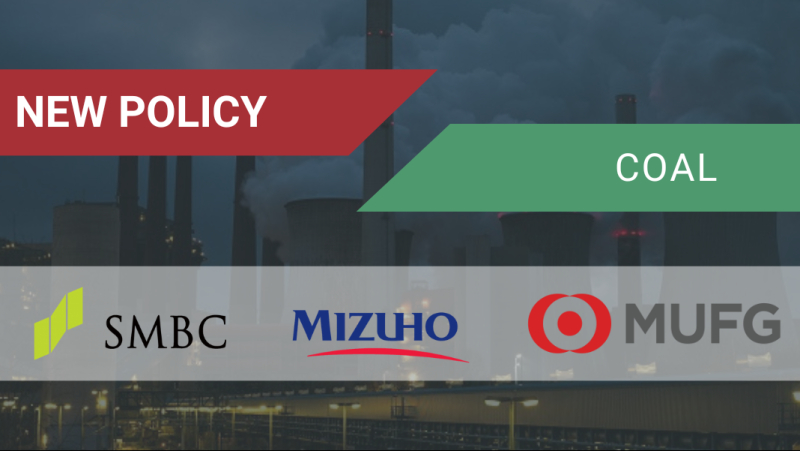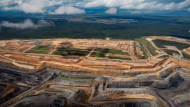Japan’s megabanks: no net-zero banking ambition

Step by step, the 3 Japanese megabanks – Mizuho, MUFG and SMBC – continue to improve their fossil fuels policies. Yet, the pace of progress remains far too slow for these Net-Zero Banking Alliance (NZBA) members. The 3 banks only exclude some new coal projects from their financial services while the bulk of the support to the coal sector comes from corporate financing. While no robust commitments have been made yet towards the oil and gas sector, all 3 keep financing companies with coal expansion plans, without any restriction. It is urgent that the 3 banks take serious measures to stop fossil fuel expansion, with priority given to those continuing to expand their coal mining and power capacity.
The 3 Japanese banks remain among the world’s fossil fuels financing behemoths.
- Mizuho, MUFG and SMBC were among the top 15 world banks financing coal between January 2019 and November 2021. They ranked respectively second ($57bn), fifth ($45bn) and thirteenth ($36bn), loans and underwritings combined (1).
- According to Banking on Climate Chaos (BOCC) 2022, MUFG, Mizuho and SMBC accounted for almost 10% of the fossil fuels financing made by the world’s top 60 banks over the 2016 – 2021 period.
Excluding new coal projects is an insufficient way-out
The 3 Japanese megabanks updated their coal commitments in the Spring. They now exclude project financing for both new thermal coal mines and new coal power plants or the expansion of existing plants.
However, while all 3 commit not to provide project financing for new thermal coal mines and for new or expansion of coal plants (2), they all still allow exceptions for some new coal plants (3). Coal plants with Carbon Capture, Utilization, and Storage could still be financed despite the fact that the technology is not commercially viable (4). MUFG and SMBC explicitly allow exceptions for mixed combustion, which goes against scientific recommendations to limit global warming to 1.5°C (5).
These commitments to exclude projects will have a very limited impact. According to the BOCC 2022, only 5% of the total fossil fuels financing was project-related (these figures are even lower for thermal coal), while 91% goes towards fossil fuels companies through corporate loans and underwritings (with an additional 4% of no-listed use of proceeds) (6).
Confronting coal mining and power companies
The 3 Japanese banks remain huge financiers of the coal industry worldwide through their support to coal companies (see figures above). A majority of this corporate financing goes towards companies listed in the Global Coal Exit List as expanding their coal mining or power capacity. Below are some of the key figures of companies with expansion plans financed by the banks between January 2019 and November 2021 (7):
| ...provided over | ...with financed companies such as | ...which is still involved | |
| Mizuho | $31bn to 43 coal developers | China Huaneng Group | in almost 28 GW of new coal power capacity in China |
| MUFG | $25bn to 39 coal developers | Marubeni Corp | in over 2 GW of new coal power plants in Indonesia, Japan and Vietnam |
| SMBC | $21bn to 38 coal developers | Adani Group | in 67Mt of new coal mining capacity, with projects such as the Carmichael Mine in Australia |
Unfortunately, these financing to coal developers will still be possible as long as the 3 Japanese banks do not adopt strict exclusion criteria at corporate level. Contrary to 36 international banks (8), none of these 3 banks restrict corporate financing to their clients operating in the coal sector. While Mizuho adopted in 2022 a criteria to exclude companies whose “primary business” is thermal coal mining or coal power generation, it only applies to new clients.
Phasing out coal
Last but not least, the 3 banks have not committed to phase out from the coal sector, contrary to 78 worldwide financial institutions, including 12 banks. Science is clear : all coal assets must be closed quickly, in order to be out of the sector by 2030 in Europe and OECD countries, and by 2040 in the rest of the world. Yet, these 3 Japanese have only committed to reach a zero exposure in project finance for coal power generation by 2040. MUFG and SMBC have also pledged to reach a zero exposure in corporate finance directly tied to coal power facilities, but this will not prevent the 2 banks from continuing to finance coal power companies (through general purpose lending for instance) (9).
Since over 90% of the total coal financing goes towards coal companies through corporate loans and underwritings, limiting the scope to only project finance or corporate finance tied to facilities is therefore in no way sufficient to phase out coal. Finally, no commitments are made regarding phasing-out (even part of) the thermal coal mining industry.
In conclusion, despite a review of their policies in 2022, the 3 Japanese banks are still lagging behind their peers, such as Credit Agricole or Unicredit (10), and are nowhere close to meeting their net-zero commitments. It is dire that they get serious about their commitments to fossil fuels, starting with the immediate exclusion of the developers. As members of the NZBA, they are asked to comply by June 2023 with the new Race to Zero criteria which require them to phase out fossil fuels and to “restrict the development, financing, and facilitation of new fossil assets”, including “no new coal projects” in line with the International Energy Agency’s Net Zero by 2050 pathway.
See the updated scoring of the Japanese banks in the Coal Policy Tool.
Notes :
- Data from a financial research done by Profundo B.V. to identify financing made to Global Coal Exit List companies between January 2019 and November 2021, for more details see this webpage.
- SMBC goes a bit further by excluding financing for the expansion of existing thermal coal mines and infrastructure dedicated to coal mining.
- Even though SMBC does not explicitly name CCUS exceptions for some coal plants projects, the bank told Japanese NGOs that exceptions were still in place in 2021, see https://fossilfreejapan.org/smbc-new-policy-may-2021/
- To date, there is still large uncertainty concerning the efficiency and costs of carbon capture and storage projects in the power sector: only two large-scale utilities currently use this technology in the world. Garcia Freites, S., & Jones, C. (2021). A Review of the Role of Fossil Fuel-Based Carbon Capture and Storage in the Energy System. Tyndall Centre
- A common fuel used for co-firing is solid biomass. The use of this wood-based energy source is counterproductive to efforts to limit global warming to 1.5°C because it creates a carbon debt, as summarized in this 2021 letter from more than 500 scientists to President Biden, President von der Leyen, President Michel, Prime Minister Suga, and President Moon.
- The research was made on the world’s top 60 banks and over the 2016 – 2021 period. Regarding coal, it analyses the financing towards the world’s top 30 coal mining and top 30 coal power companies.
- See note 1.
- Banks that have taken commitments to exclude coal companies (based on relative and/or absolute thresholds, or companies with expansion plans), both new and existing clients, assessed in the Coal Policy Tool. The robustness of these exclusions can vary among these banks.
- More details on MUFG’s policy and SMBC’s policy can be accessed in press releases from 350 Japan.
- The 2 banks have committed not to finance any coal companies with power, mining or infrastructure expansion plans. They also have committed to a full coal mining and power phase-out strategy by 2028 worldwide (UniCredit) and 2030 for the EU/OECD countries and 2040 worldwide (Credit Agricole).
Resources:
- Mizuho, Press release, May 17th 2022
- MUFG updated policy and Progress Report, April 1st, 2022
- SMBC, Strengthening efforts against climate change and Management of Environmental Risks, May 13th 2022
- The Coal Policy Tool
- The Oil and Gas Policy Tracker



